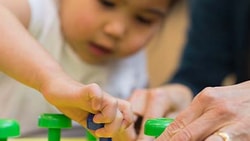Self-Regulation in Childhood: A Neuroscience-Informed Approach for Clinicians
Help children build lasting self-regulation skills by addressing the brain–body connection at its core. Explore neuroscience-based strategies and sensory-informed interventions to support adaptive, sustainable regulation.
August 20, 2025
8 min. read

Self-regulation is more than “calming down” or “staying focused.” It’s a dynamic brain-body process that shapes how children engage, learn, and connect. When we look at it through a neuroscience lens, the picture changes—behavior becomes communication, and intervention becomes an opportunity to rewire the nervous system.
With more than two decades of experience working with children and families, I’ve seen how sensory processing, emotional regulation, and executive function work together—or fall out of sync—to influence everything from play to participation.
In this article, we’ll explore the neurological foundations of self-regulation, the sensory systems that drive it, and practical strategies you can use to help children build adaptive, sustainable regulation skills.
How the brain and body work together in self-regulation
Self-regulation is a triad of interconnected systems working together to help children navigate daily life. It involves:
Sensory processing: How the nervous system takes in and interprets information from the environment and the body.
Emotional regulation: How we adapt to stress, excitement, fear, or frustration.
Executive function: How we think, plan, and respond instead of react.
When any part of this triad is out of balance—especially in children with autism, ADHD, trauma histories, or sensory processing disorder—the signs often show up as changes in behavior.1,2 A child may melt down, withdraw, or seek intense sensory input.
But behavior is only an outward expression. Beneath the surface, a neurological story unfolds: Sensory pathways send signals, emotional centers react, and executive functions either step in or fail to guide an appropriate response.
Every child has a unique threshold for sensory input, the point at which stimulation is strong or long enough to trigger a reaction.2 Some thrive on high-intensity activities because it takes more input to reach that threshold. Others reach it quickly and become overwhelmed, shifting into fight-or-flight. This variation is why two children can experience the same situation so differently, and why interventions must be individualized.
Understanding this brain-body connection is key to designing strategies that target root causes, not just surface behaviors. We must shift our role from “managing behavior” to supporting the underlying systems so children can develop lasting self-regulation skills.
Understanding the root causes of dysregulation
Most people are taught that humans have five senses. But in pediatric therapy, and especially in occupational therapy, we work with a far more complex sensory network. In addition to the traditional five (sight, sound, touch, taste, smell), there are several “hidden” senses that play a critical role in self-regulation and daily function:1
Proprioception: Awareness of where the body is in space, guided by receptors in the muscles and joints.
Vestibular input: Balance, movement, and spatial orientation, influenced by the inner ear.
Interoception: Internal sensations like hunger, thirst, heart rate, or the need to use the restroom.
Thermoception: The ability to detect temperature changes.
Nociception: The ability to detect pain, pressure, or potentially harmful stimuli.
These systems work together constantly, often below conscious awareness. When they are hypo-responsive (under-reactive) or hyper-responsive (over-reactive), children may display behaviors like meltdowns, withdrawal, or intense sensory seeking.
These patterns are not random—they are neurological. For example, a child hypersensitive to sound may cover their ears and retreat when the classroom gets loud, while another child with reduced proprioceptive awareness may seek deep pressure through hugs or pushing against furniture.
That’s why I lean on a multi-sensory approach, considering how the senses overlap, influence one another, and connect to the brain’s regulatory systems. When we understand those relationships, we can design interventions that truly match the child’s unique sensory profile at a neurological level, rather than chasing surface behaviors.
The hidden routes of self-regulation
Beneath every behavior is a network of neural highways, where sensory information travels at remarkable speed between the body and the brain. One example is the spinothalamic tract, which carries pain and temperature signals upward to be processed. But these pathways don’t work in isolation. They intersect with emotional hubs like the limbic system, which means a stimulus can trigger a fight-or-flight reaction before the child is even aware of what’s happening.3
For some children, these routes are unusually reactive. A child who bangs their head or bites their hand may not be “acting out,” but instead instinctively activating their nervous system in a bid to self-regulate. Here’s the takeaway: we can engage these same pathways in ways that are both safe and therapeutic, giving the nervous system what it craves without feeding harmful patterns.
One of the most influential of these routes is the vagus nerve. Running from the brainstem to nearly every organ, it acts as a direct line between mind and body, shifting the nervous system from fight-or-flight into rest-and-digest mode.3 Many children activate it instinctively through humming, rhythmic rocking, rolling into inversion poses, or pressing their face into a cool surface, without realizing they’re calming themselves.
Behavior as the brain’s language
When we understand these hidden neurological routes, behavior starts to look less like defiance and more like communication. Instead of reacting to what we see on the surface, we can respond to what the nervous system is trying to say and choose strategies that meet that underlying need.
In practice, this might look like:
Autism: Self-stimulatory behaviors (like hand-flapping or rocking) may be an attempt to organize overwhelming sensory input.
ADHD: Constant movement or fidgeting can be a way to reach the sensory threshold needed for focus.
Trauma: Hypervigilance or emotional shutdown may be the nervous system’s way of staying safe.
The child’s state influences ours, and our state influences theirs. I call this reciprocal regulation because it’s a two-way exchange. If we enter a session feeling rushed or tense, the child’s dysregulation can intensify. But when we lead with grounded breath, intentional posture, and calm tone, we not only help them regulate in the moment—we model the skills they’ll need to self-regulate on their own.
Strategies for sustainable self-regulation
The most effective self-regulation strategies work with the nervous system, not against it. By targeting specific neurological pathways, these techniques help children regulate in the moment while building stronger, more adaptive brain connections over time.
1. Hills and valleys breathing
A visual breathwork exercise that guides children along a star-shaped path for inhale and exhale cycles. This rhythmic, patterned breathing supports autonomic nervous system regulation and improves focus.
2. Trumpet breathing
A resistive blowing activity that mimics the Valsalva maneuver, stimulating vagal pathways and encouraging a shift from fight-or-flight to a parasympathetic, rest-and-digest state.
3. Ear massage
Gentle stimulation of the external ear to activate the auricular branch of the vagus nerve. Particularly beneficial for younger children, this tactile input can quickly support downregulation.
4. Environmental scanning
Using a Contextual Sensory Investigation (CSI) approach to pinpoint and adjust environmental triggers such as harsh lighting, excessive wall décor, or strong odors that may tip the nervous system toward dysregulation.
These approaches are more than “calming techniques.” They’re targeted, evidence-informed interventions designed to harness neuroplasticity, helping children develop lasting, flexible self-regulation skills that support learning, connection, and independence.
From co-regulation to lasting change
The brain’s capacity for growth is extraordinary. As the saying goes, “Neurons that fire together, wire together.” When we consistently pair safety, connection, and supportive sensory experiences, we help children strengthen new neural pathways, gradually replacing dysregulated patterns with more adaptive ones.
In practice, this might mean structured breathwork to anchor the autonomic nervous system, rhythmic movement that engages vestibular and proprioceptive input, targeted sensory activities that meet the child’s unique thresholds, or environmental adjustments that reduce triggers before they overwhelm. No two children need the exact same combination, but the most effective plans share one thing in common: They’re grounded in an understanding of the sensory systems, neurological pathways, and the brain–body connection.
If you want to dive deeper into this framework and expand your continuing education, explore my Medbridge courses:
Neuroscience of Self-Regulation in Childhood: Pathways to Growth: Understand the neurological foundations of self-regulation and their impact on conditions like ADHD, autism, and sensory processing challenges.
Neuroscience of Self-Regulation in Childhood: Interventions: Learn practical, evidence-based techniques (including mindfulness strategies and primitive reflex testing) with real-life examples for immediate application.
The Enteric Nervous System, Brain–Gut Connection, and Primitive Reflexes: Discover how the gut–brain axis, vagus nerve, and reflex integration influence regulation, and how to design targeted interventions that promote lasting change.
References
Fernandez-Prieto, M., Moreira, C., Cruz, S., Campos, V., Martínez-Regueiro, R., Taboada, M., Carracedo, A., & Sampaio, A. (2021). Executive Functioning: A Mediator Between Sensory Processing and Behaviour in Autism Spectrum Disorder. Journal of autism and developmental disorders, 51(6), 2091–2103. https://pubmed.ncbi.nlm.nih.gov/32915356/
Panagiotidi, M., Overton, P. G., & Stafford, T. (2020). The relationship between sensory processing sensitivity and attention deficit hyperactivity disorder traits: A spectrum approach. Psychiatry research, 293, 113477. https://pubmed.ncbi.nlm.nih.gov/33198048/
Koban, L., Gianaros, P.J., Kober, H. et al. The self in context: brain systems linking mental and physical health. Nat Rev Neurosci 22, 309–322 (2021). https://www.nature.com/articles/s41583-021-00446-8
Below, watch Varleisha D. Lyons discuss the self-regulation and coregulation in this brief clip from her Medbridge course "Neuroscience of Self-Regulation in Childhood: Pathways to Growth."






